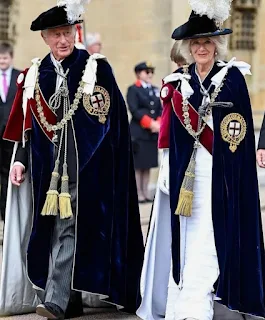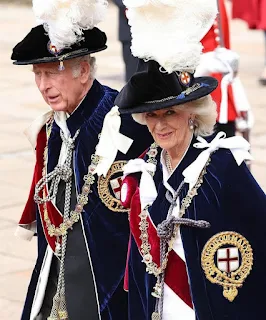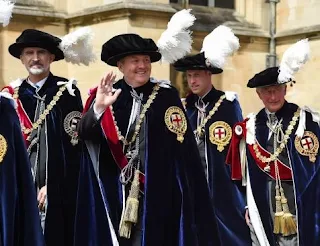The original records of the order were reportedly destroyed by fire, so it's difficult for historians and researchers to obtain information about its original purposes.
However, one theory suggests that, apart from King Edward III's intention to revive the legend of King Arthur's Knights of the Round Table, there was one incident that attributed to the establishment.
Diplomatic banquet in Buckingham Palace (2015). The Queen, Prince Charles, Prince Philip, and Prince William wore their Garter sash. the Princes wore a garter on one leg as per medieval tradition
According to one theory, the order was established to commemorate an incident where Edward III was dancing and one of his partner's blue garters dropped to the floor.
He gallantly picked up the garter and put it on his leg, admonishing courtiers in French: "Honi soit qui mal y pense, in English - Shame to him who thinks evil of it", which remains the motto of the Order of the Garter until today. This tradition of putting the garter on one leg is still practiced by the Royal Knights (as seen in the above photo).
How the Order is Granted?
During the medieval time, the Order of the Garter's membership consisted of the monarch and the heir-apparent (the Prince of Wales), and each has 12 companions (as if at a tournament).
The Prince of Wales, the Queen, and the Duke of Cambridge in the previous Garter Day
However, during the reign of King George III in the 18th century, he added two types of memberships called supernumeraries, comprised of members of the royal family (known as Royal Knights Companion) to accommodate his several sons, and Extra Knights - to appoint other chosen lineal descendants of King George I and foreign monarchs.
Today, membership is limited to 24 distinguished individuals. The British Sovereign and the heir-apparent are always the automatic members of the order.
The appointment to the order is solely at the discretion of the British sovereign. Usually, the recipients are those who have distinguished national contributions to public service or to personal service to the sovereign.
Supernumerary members of the Order of the Garter do not count towards the limit of the 24 companions. Supernumerary members are usually members of the Royal Family.
The British sovereign began appointing foreign monarchs into the Order, known as Stranger Knights and Ladies of the Garter, in the middle of the 19th century.
During the Garter Day, members wore elaborate Garter vestments which include the Mantle, the Tudor bonnet (hat) with white feathers, the collar with white ribbons tied in bows on the shoulders, and the Garter worn around the left calf by knights and around the left arm by Ladies.
And because it is considered the highest order in the civil and military honors in the British system, Knights of the Garter are ranked above Knights of the Thistle (in Scotland), these are the two oldest and most honored Knighthood in the United Kingdom.
The Order has five officers: Prelate (who is always the Bishop of Winchester), Chancellor, Registrar (Dean of Windsor since the reign of Charles I), Garter King of Arms, and Gentleman Usher of the Black Rod.
The Order feast day is April 23rd in honor of the patron saint of the Order of the Garter, St. George. The chapel of the order is St. George’s Chapel in Windsor. In fact, each knight has a stall assigned to him in this chapel. Placed in it are his banner, helmet, and a stall plate bearing his arms.
The banners and helmets of the knights are taken down after their death, but the stall plates, of which the oldest dates probably from 1390, remain permanently fixed in the stalls. As a result of this tradition, the stalls of St. George’s Chapel provide one of Europe’s finest collections of historic heraldic design.
The insignia of the order comprises the garter with the motto emblazoned on it, the star with St. George’s cross, and a collar with a badge representing St. George and the dragon. All insignia are returned to the order on the death of the holder.
Male members of the Order are titled "Knights Companion" and female members are called "Ladies Companion". All Queen Consorts are traditionally appointed as Ladies of the Garter but not the wives of the sons of the Sovereign.
Why Camilla was appointed and Diana was not?
One of the highlights of this year's Garter Day was the appointment of the Duchess of Cornwall into the Order, which raised eyebrows from royal fans. Traditionally, no spouses of the Sovereign's sons, even if that son is the heir-apparent, ever appointed into the Order of the Garter.
The Prince of Wales and the Duchess of Cornwall. Credit: The Royal Family
Princess Diana, for instance, even though the wife of the heir-apparent and had a massive contribution to public duties, was not appointed into the order during her tenure as Princess of Wales, for the fact that a wife of the heir to the throne is not customarily invested into the Order of the Garter while she is not yet the Queen Consort.
The Queen and the Duke of Edinburgh
The wife or husband of the first-in-line to the throne is usually appointed into the Order upon the accession to the throne of the spouse. However, there was an exemption made in 1947. King George VI appointed his second cousin and son-in-law, Prince Philip, Duke of Edinburgh, into the Order on the night of his wedding to Princess Elizabeth.
The Queen and the Duke of Edinburgh
There were no established rules or criteria for royal family members who among them will receive the honor. It is always at the sole discretion of the monarch.
The Sovereign personally selects Knights and Ladies Companion of the Garter and does not require to solicit the advice of the Government.
The Countess of Wessex and the Duchess of Cambridge attended this year's Garter Day
Credit: The Royal Family
The current Royal Knights and Ladies Companion are all working royals. Children of the Sovereigns are usually admitted into the Order after rendering commendable services to the monarchy and the commonwealth.
The Earl of Wessex and the Countess of Wessex. Credit: The Royal Family
The Princess Royal Credit: The Royal Family
So why the Duchess of Cornwall is prematurely admitted into the Order? (Premature because Prince Charles is not yet the Sovereign). The following reasons might be in the Queen's mind when she made the decision.
This year, it seems there's a necessity for Camilla to be named Royal Lady Companion, probably because there's a vacancy - the seat left by the Duke of Edinburgh since his death in 2021. The Queen in her message to the nation a few months back emphasized she wished Camilla to be named Queen Consort when Charles ascends the throne.
Duchess of Cornwall, the Prince of Wales, and the Duke and Duchess of Cambridge. Credit: The Royal Family
The honor she recently granted to the Duchess of Cornwall, which is considered the highest honor of distinction in the British Knighthood system, seems to solidify this intention of making Camilla a Queen Consort. And not Princess Consort as previously agreed when Camilla and Charles wed in 2005.
The Prince of Wales and the Duchess of Cornwall. Credit: The Royal Family
The Queen perhaps wants to honor Camilla for the services she has rendered to the monarchy, because lately, as the Queen limits her public activities due to mobility issues, Camilla and Prince Charles have been in the forefront of royal duties, representing the Queen in many public events.
The Duchess of Cornwall jas been performing her royal role more than what is expected from the wife of the heir-apparent. Thus, the Queen probably thought it is just appropriate to make the Duchess of Cornwall the Royal Lady Companion of the Garter this year.
Why Prince William is a member but not Prince Harry
Prince William was appointed in 2008 to the Order of the Garter at the young age of 25. He was the 1000th Knight of the Order. He was appointed in his capacity as the direct heir. While his brother, Prince Harry, as a younger son, would have to wait for his father to become king before he would be invested into the Order.
However, the possibility of Prince Harry to be admitted to the Order is becoming too dim because he is no longer a working royal.
King Felipe VI and King Willem-Alexander are two foreign monarchs who are appointed into the Order
Here are the current members and Companions of the Order of the Garter, apart from The Queen and the Prince of Wales who are the automatic members.
1. The Duke of Abercorn
2. Field Marshal The Lord Inge
3. The Lord Butler of Brockwell
4. The Lord Morris of Aberavon
5. Sir John Major (former British Prime Minister)
6. The Lord Luce
7. Sir Thomas Dunne
8. The Lord Phillips of Worth Matravers
9. The Lord Boyce, Admiral of the Fleet
10. The Lord Stirrup, Marshal of the Royal Air Force
11. The Baronness Manningham-Buller
12. The Lord King of Lothbury
13. The Shuttleworth
14. Sir David Brewer
15. The Viscount Brookeborough
16. Lady Mary Fagan
17. The Marquess of Salisbury
18. Lady Mary Peters
19. The Baroness Amos
20. Sir Tony Blair (former British Prime Minister)
21-24 vacant
Royal Knights and Ladies Companion (and the year of membership). Currently, all working royal family members (Prince Andrew already stepped back from public life and most of his military honors and patronages were returned to the Queen but he remained a Royal Knight Companion of the Garter) are Companions of the Garter.
1. Prince Edward, the Duke of Kent (1985)
2. Anne, the Princess Royal (1994)
3. Prince Richard, the Duke of Gloucester (1997)
4. Princess Alexandra, The Lady Ogilvy (2003)
5. Prince Andrew, the Duke of York (2006)
6. Prince Edward, the Earl of Wessex (2006)
7. Prince William, the Duke of Cambridge (2008)
8. Camilla, the Duchess of Cornwall (2022)
Stranger Knights and Ladies Companion (Extra Knights).
All foreign monarchs who are direct descendants of King George I are appointed into the order. With the exemption of the former Emperor of Japan, all current Extra Knights and Ladies Companion are direct descendants of King George I. They did not comprise the 24-membership of the Garter.
1. Queen Margrethe II of Denmark (1979)
2. King Carl XVI Gustaf of Sweden (1983)
3. King Emeritus, Juan Carlos I of Spain (1988)
4. Queen Beatrix of the Netherlands (1989)
5. Emperor Emeritus Akihito of Japan (1998)
6. King Harald V of Norway (2001)
7. King Felipe VI of Spain (2017)
8. King Willem-Alexander of The Netherlands (2018)























0 Comments